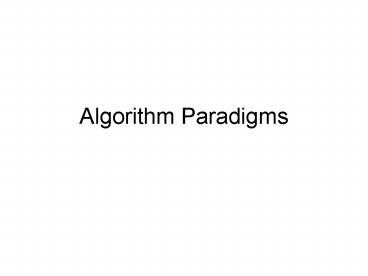Algorithm Paradigms - PowerPoint PPT Presentation
1 / 11
Title: Algorithm Paradigms
1
Algorithm Paradigms
2
Algorithm Paradigms
- Search (BFS, DFS)
- often good when guided by a heuristic
- Divide and Conquer
- Good when subproblems are independent
- Randomization
- Good when any choice is equally good
3
Algorithm Paradigms
- Greedy Algorithms
- Dijkstras Algorithm for shortest distance
- Dynamic Programming
- Longest common subsequence
- (programming isnt computer programming)
4
Greedy Algorithm
- A greedy approach does not always lead to an
optimal solution - Appropriate if a good local choice is also a good
global choice - Examples
- Huffman coding (computing optimal code)
- Kruskals algorithm
5
Dynamic Programming
- Simple subproblems
- Subproblem optimization
- Subproblem overlap
- Optimal solutions to subproblems are computed
only once, and stored in a table - consider the space complexity
6
Knapsack problem
- n items, each worth vi and weighing wi
- Goal is to fill knapsack of capacity W pounds
with maximum value of items - 0 1 knapsack problem include or reject each
item - fractional knapsack problem can include
fractional amounts of each item
7
Fractional Knapsack problem
- Greedy algorithm
- Compute each items value per pound vi / wi
- Sort items by value per pound
- Fill knapsack by taking most valuable item first,
until knapsack is full
8
0 1 Knapsack problem
- Greedy approach is not optimal
- Item 1 value 5 weight 3 pounds 1.67
- Item 2 value 3.1 weight 2 pounds 1.55
- Item 3 value 2 weight 2 pounds 1.00
- Knapsack holds 4 pounds
9
0 1 Knapsack problem
- Exhaustive enumeration (brute-force approach)
isnt too speedy - There are n items, so 2n subsets.
- Dont want to check each one!
10
0 1 Knapsack problem
- Dynamic programming approach
- Build a 2-D table Ti,j
- i means using items 1 i ( 1 i n )
- j means max capacity ( 1 j w )
- Ti,j is the maximum value obtainable with items
1 through i weighing at most j - Ti,j max (Ti-1,j , vi Ti-1, j-wi )
- max ( dont include item i, or do and optimize
remaining space in knapsack)
11
0 1 Knapsack problem
- Ti,j max (Ti-1,j , vi Ti-1, j-wi )
- Fill in i 1 row with vi if wi gt j
- T , lt 0 is 0
j 1 2 3 4 1 0 0 5 5
i 2 0 3.1 5 5 3 0 3.1 5 5.1































